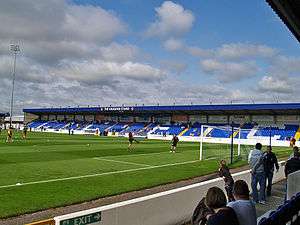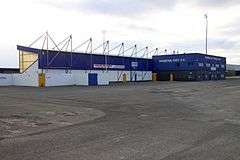Deva Stadium
 | |
| Full name | Swansway Chester Stadium |
|---|---|
| Location |
Bumpers Lane Chester CH1 4LT |
| Coordinates | 53°11′21″N 2°55′26″W / 53.1892°N 2.9238°WCoordinates: 53°11′21″N 2°55′26″W / 53.1892°N 2.9238°W |
| Owner | Cheshire West and Chester Council |
| Capacity | 5,376 (4,170 Seated) |
| Record attendance | 5,987 |
| Field size | 112 x 71.5 metres |
| Surface | Grass |
| Construction | |
| Broke ground | 26 January 1992 |
| Built | 1992 |
| Opened | 25 August 1992 |
| Tenants | |
|
Chester City F.C. (1992–2010) Chester F.C. (2010– present) Liverpool U21 (2014–2016) | |
| Website | |
| Deva Stadium on Chester FC website | |
The Deva Stadium (also currently known as the Swansway Chester Stadium due to sponsorship reasons[1]) is an association football stadium in England (though the pitch is in Wales),[2] that is the home of Chester F.C., the effective successor club to the liquidated Chester City F.C. The name Deva comes from the original Roman name for the fort Deva Victrix, which became the city of Chester, in North West England.
The Deva Stadium opened in 1992, two years after the closure of Chester City's Sealand Road stadium; in the intervening two seasons the club had played at Macclesfield Town's Moss Rose stadium.
History

When a new owner took over Chester City in March 1990, plans were announced to sell its Sealand Road stadium for redevelopment as a supermarket and build a new stadium at nearby Bumpers Lane. While the new stadium was being built they played at the far side of Cheshire at Macclesfield Town F.C.'s Moss Rose stadium. Sealand Road closed at the end of the 1989–90 season, and Chester played at Macclesfield for the next two seasons.[3]
Construction of the new stadium began in January 1992 and it opened seven months later in time for the new 1992–93 season.
It was the first English football stadium to fulfil the safety recommendations from the Taylor Report, which was commissioned after the Bradford Fire of 1985 and after the Hillsborough disaster of 1989. Walsall's Bescot Stadium had opened in August 1990, seven months after the report was published, but construction had started before the end of 1989.[4]
The stadium was officially opened on 24 August 1992 by Conservative Party peer Morys Bruce, 4th Baron Aberdare.[5]
The stadium hosted its first game the next day, when Chester lost 2–1 in the League Cup to Stockport County. 11 days later, Chester beat Burnley 3–0 in the first Football League match on the ground. On 13 October 1992, Chester beat a Manchester United XI 2–0. Its tenth anniversary in August 2002 was celebrated with a special friendly against a Liverpool XI, with Chester winning 1–0.
Between 2004 and 2007 it was officially known as the Saunders Honda Stadium for sponsorship purposes, before reverting to the Deva Stadium for the 2007–08 season.
On 2 May 2008 it was announced that as of the 2008–09 season, the Deva would be known as The Cestrian Trading stadium.[6]
In February 2010, The New Saints of the Welsh Premier League formally applied for a groundshare with Chester City, who had lost their league status the previous year and were by now deep in debt and on the verge of closure, at the Deva Stadium.[7] However, TNS ultimately decided to remain at Park Hall in Oswestry.
Chester City were dissolved with huge debts on 10 March 2010, two days after being expelled from the Conference Premier (to which they had been relegated from The Football League the previous season), and as a result the stadium was left without a tenant. In May 2010 the owners of the ground, Chester and Cheshire West council awarded the lease to the newly formed phoenix club Chester F.C.[8][9]
The first Chester F.C. match at the stadium was a 3–0 victory over Aberystwyth Town in a friendly on 24 July 2010.
Location
The stadium is located in the Sealand Road Industrial Estate. The stadium is known to be on the border between England and Wales as the border runs along the rear of the east stand (the main stand). The address of the ground is officially classed as England, due to the main entrance of the building being in England.[10]
Facilities
The stadium initially had a capacity of 6,000 before the away end was converted to seating, and now holds 5,400.
The Deva Stadium has three sides of seating and one terraced end. The largest stand, known as the Red Insure (main) Stand, and The Harry McNally Terrace are both for home fans. The West Stand is mostly for home fans, but has a small section for away fans and the South Stand is exclusively for away fans. In summer 2007, Chester converted the South Stand from terracing to seating (as mentioned above). There have been few other changes of significance in the 15-year history of the Deva Stadium, although the North Terrace was renamed the Harry McNally Terrace in December 2006 in honour of one of its most popular managers (who died two years earlier). In 2010, the main stand was renamed the Exacta Stand.
References
- ↑ Green, Jim. "Chester FC announce new stadium sponsorship deal". Chester Chronicle. Retrieved 2016-03-20.
- ↑ Deva Stadium map
- ↑
- ↑ Chas Sumner (1997). On the Borderline: The Official History of Chester City 1885–1997. p. 127. ISBN 1-874427-52-6.
- ↑ "The Football Supporters' Federation – Chester". Fsf.org.uk. 24 August 1992. Archived from the original on 30 December 2010.
- ↑ "Sport: Latest Football, Boxing, Rugby League and Cricket News – Liverpool Echo". Liverpooldailypost.co.uk. 2016-01-09. Retrieved 2016-03-20.
- ↑ "The New Saints look at moving to Chester's Deva Stadium". BBC Sport. 10 February 2010. Retrieved 19 February 2010.
- ↑ "Chester wound up at court hearing". BBC News. 10 March 2010.
- ↑ Nakrani, Sachin (10 March 2010). "Chester City wound up in high court". The Guardian. London.
- ↑ "The Swansway Chester Stadium". Chester F.C. Archived from the original on 21 December 2014. Retrieved 16 April 2015.
External links
| Wikimedia Commons has media related to Deva Stadium. |